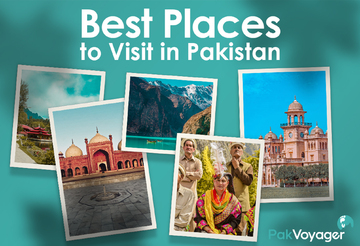Best Places to Visit in Pakistan
From the Karakoram, Hindu Kush and Himalayan mountain ranges to the serene alpine lakes that call them home, wondrous landscapes aren’t in short supply in northern Pakistan. But where exactly are the best places to visit in Pakistan?
Below is a selection of our favourite destinations in Pakistan, whether you’re looking to soak up some culture, put your adventure skills to use or simply discover pure serenity.
Hunza Valley
Location: In the extreme north of Pakistan next to the Chinese border, within the Gilgit-Baltistan region.
How to get there: Fly from Islamabad to Gilgit, then continue by road. You can rent a car and drive one and a half to two hours or take a bus, travelling along the beautiful Karakoram Highway to Hunza.
There’s no doubt that Hunza Valley is one of the top places to visit in Pakistan. The region’s culture has been shaped over time, not only by its inhabitants but also by the travellers and merchants that have passed through along the Silk Road. Hunza is a largely untapped haven of culture and warm hospitality, with more than its fair share of natural beauty.
Snow-covered mountains rule the landscape here, their peaks often hidden by ethereal mist. It’s one of the best places to visit in Pakistan for adventure – think cycling or biking along the Karakoram Highway, hiking mountain trails, like Ondra Poygah, and exploring ancient glaciers, like Batura glacier.
There are plenty of important cultural spots to explore too, including Baltit Fort and Altit Fort, both past residences of Hunza’s royal family. Attabad Lake is also well worth a visit. It has a rather sad tale to tell. Though an incredibly beautiful part of Hunza’s landscape now, it only came into existence in 2010, when a landslide destroyed the village that sat where the lake is now. The landslide also blocked the Hunza River, which led to the lake’s creation.
Find out more about Hunza Valley Explore Hunza Valley.
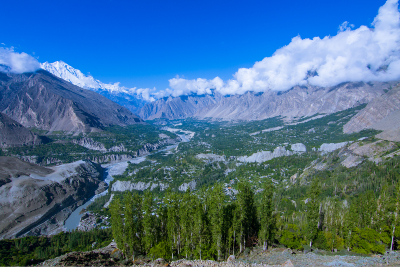
Swat Valley
Location: In the north of Pakistan, close to the Afghanistan border.
How to get there: Fly to either Peshawar city or Islamabad, then take a bus or rent a car and drive to Swat Valley. By car, the journey takes three and a half hours from Peshawar or four hours from Islamabad.
Known as the Switzerland of the East, Swat Valley is a region full of snow-capped mountains and dotted with charming red cottages. The valley sits in the foothills of the Hindu Kush mountain range with the Swat River running through its centre.
The home of Malala Yousadzai noble peace prize winner, Swat is one of the best tourist places in Pakistan. Visit now and you’ll find a region of peace, with a rich Buddhist history and endless natural wonder to explore.
High up in the Hindu Kush mountains is the Malam Jabba Ski Resort, one of the best places to visit in Pakistan for winter skiing. And you can’t visit Swat Valley without a trip to the Butkara Stupa, an important archaeological and historical site. The main stupa, which is thought to have been started in the 3rd century BC by Ashoka, stands in the centre of the site, and small stupas built by pilgrims stand around it.
Find out more about Swat Valley Explore Swat Valley.
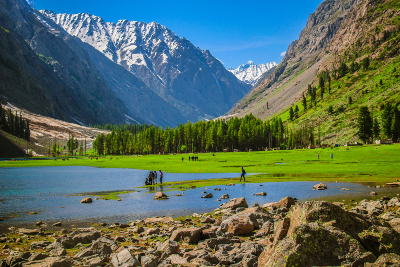
Chitral
Location: In the northwest of Pakistan, close to the Afghanistan border.
How to get there: The quickest way to reach Chitral is by flying from Islamabad. However, you can also take a bus or rent a car and drive from Islamabad, Peshawar or Gilgit. Though these drives are long, it gives you the chance to enjoy northern Pakistan’s breathtaking scenery.
Chitral Valley is one of the most secluded regions in the Khyber Pakhtunkhwa province but it’s well worth making the journey here. Set in the Hindu Kush mountains, its picturesque landscapes are truly awe-inspiring but what sets Chitral apart is its rich culture. A visit to Chitral Valley is the chance to experience the locals’ simple way of life for yourself and enjoy faultless hospitality wherever you venture.
Explore the town of Chitral and you’ll get to uncover the region’s history, not least through the Chitral Museum. The region is also home to one of the best places to visit in Pakistan, the Kalash valleys. In the valleys of Bumburet, Birir and Rumber live the Kalash tribes, who live separately from the rest of civilization and enjoy traditions that remain unaffected by modern times.
Find out more about Chitral Valley. Explore Chitral Valley.
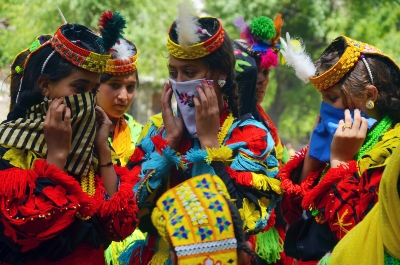
Skardu Valley
Location: In the northeast of Pakistan.
How to get there: You can reach Skardu Valley by flying from Islamabad, or take a bus or rent a car and drive from Islamabad or Gilgit and drive to Skardu along the Karakoram Highway. The main route, the route that all public transport takes, is along the Karakoram Highway to Alam Bridge (just south of Gilgit city) and along Skardu Road to Skardu. If renting a car and driving yourself, another option is to take the Karakoram Highway to midway between Chilas and Gilgit, then take Astore Valley Road that leads to Astore Valley then through Dewsai National Park on to Skardu. Though this road isn’t metaled in some parts, many people prefer this route for its serenity and the amazing landscapes it offers up. Note, however, that the road is closed at Dewsai National Park in winter due to heavy snowfall.
Skardu Valley brings together a variety of landscapes: desert, mountains, meadows and forests. Some of the world’s highest mountain peaks call the region home and create a stunning backdrop for the lush green meadows and the Katpana Desert’s cold desert dunes.
Skardu is the perfect gateway to some of the world’s tallest mountains, making it the best place to visit in Pakistan for adventurers. The Skardu region boasts K2, the second highest mountain in the world, and the Trango Tower Peaks, offering up some of the toughest rock climbing terrain in the world.
History lovers have plenty to explore here too. Places like Khaplu Palace and Shigar Fort, past homes of Skardu royalty, stand as a testament to the area’s past. Today, they house hotels and museums that help paint the picture of Skardu’s history.
Find out more about Skardu Valley Explore Skardu Valley.
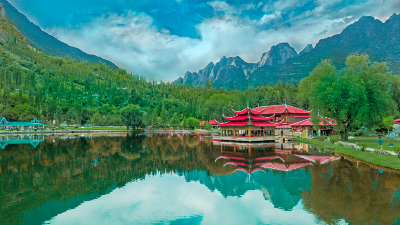
Lahore
Location: In the east of Pakistan, near the Indian border.
How to get there: Fly into Lahore. Many major airlines service Lahore’s Allama Iqbal International Airport.
The city of Lahore is the cultural centre of Pakistan’s Punjab province and the second-largest city in the country after Karachi. In contrast to Islamabad, Lahore has stood for centuries and its rich history can be seen in its architecture: some stunningly intricate and some far more disorderly.
The old part of the city used to be bordered by a wall but, for the most part, the wall has been replaced with open parks and gardens filled with greenery and water. To the southeast of the old city is the newer part, which fades out into the bustling suburbs.
The old city is home to the ornately decorated Wazīr Khān Mosque and Lahore Fort, a truly beautiful example of Mughal architecture. This fortress was constructed in the Mughal era and includes palaces, gardens and museums. It’s a beautiful place to explore, decorated in marble and stunning tile work. Experiencing Lahore’s food scene is also a must. Get a taste of authentic Pakistani dishes by sampling the city’s food street and wander the Anarkali Bazaar to shop for local food, clothes and other treasures.
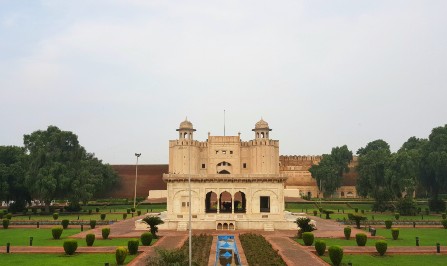
Peshawar
Location: In the Khyber Pakhtunkhwa province in northern Pakistan.
How to get there: Fly to Bacha Khan International Airport Peshawar from a selection of Middle Eastern destinations or catch a domestic flight from Lahore, Karachi or Islamabad. It’s also possible to reach via road from Lahore or Islamabad, either by renting a car or catching a bus.
Peshawar, meaning ‘frontier town’, is the capital of Pakistan’s Khyber Pakhtunkhwa province and acts as its cultural and economic centre. It’s not far away from the Khyber Pass which was once part of the Silk Road. From textile to sugar mills, the city boasts a fair few industries that make it a prosperous place.
It used to be the capital of the ancient Buddhist kingdom of Gandhara. Today, the city’s bustling streets are full of rickshaws taking people from A to B, historic buildings and remnants from its Buddhist past. Peshawar’s beautiful architecture makes it a dream to explore, like the 17th century Mughal Mahabat Khan Mosque, with its highly decorated interior and welcoming courtyard. Make sure to visit the Peshawar Museum in the centre of the city too; not only is the historic building itself a treat to see, but it also houses artefacts that help shed a light on Peshawar’s history.
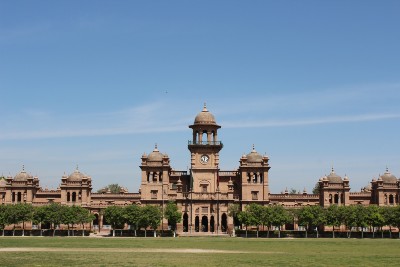
Astore Valley
Location: In the northeast of Pakistan in the Gilgit-Baltistan region.
How to get there: Take a bus or rent a car and drive from Gilgit to the city of Astore. The drive takes approximately two and a half hours by car and longer by bus. Alternatively, it’s possible to drive from Chilas too, which also takes about two and a half hours.
Not only is Astore Valley known for the beautiful scenery typical of this part of Pakistan, but it also has a simple charm all of its own. Take a walk through some of the different villages in the valley and you’ll find a lovely atmosphere against the backdrop of ice-cold streams, lush green pastures, towering mountains – everything that makes Astore Valley one of the best places to visit in northern Pakistan.
The Valley is set at the eastern face of Nanga Parbat, the Killer Mountain. Laila Peak, Chongra Peak and Rakhiot Peak help form the awe-inspiring backdrop too, along with the thick forests of pine, cedar and fir trees.
One of the best spots to visit in Astore Valley is Rama Meadows, near the city of Astore. At an elevation of 3,300 metres, these pristine meadows are famous for their lush green plains, babbling brooks and pretty views. Trekking up from the Meadows is a must too, where you can visit the stunning Rama Lake. Astore Valley is also a great place from which to visit Deosai Plateau, the 2nd highest plateau in the world.
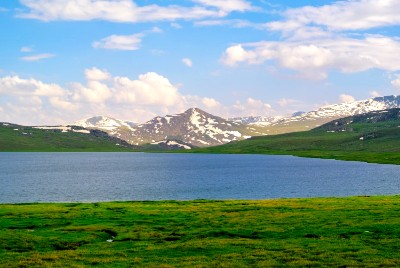
Islamabad
Location: In the mid-north of Pakistan; the gateway to northern Pakistan regions.
How to get there: Visitors can fly into Islamabad. Many major airlines operate flights here.
The capital city of Pakistan is surprisingly modern. Though it's never neglected its history nor its cultural influences, it’s an undeniably forward-thinking city. It’s a well-thought-out metropolis, created as a capital city in 14 August 1967. The city is laid out in a grid pattern, with an abundance of lush green spaces too.
Though many are tempted to treat Islamabad as a city best passed through on the way to Pakistan’s stunning northern regions, it’s an emerging travel destination and a stay here is the best way to experience the modern side of Pakistan. There’s plenty to see and do, including the impressive Shah Faisal Mosque and the Pakistan Monument. Visitors can also take in the incredible views across Islamabad as they hike along Margalla Hills trails, and sample delicious food at some great restaurants that sit atop the hills.
If you fancy experiencing the older side of Pakistan whilst in Islamabad, take a trip to Islamabad’s nearby sister city, Rawalpindi – it’s older, sprawling and slightly chaotic.
Islamabad is a fairly walkable city. An evening stroll around Fatima Jinnah Park is the ideal way to soak up the city’s atmosphere. In fact, walking might just be the best way to get a real feel for the place. If you don’t fancy walking all the time, however, getting a taxi or an Uber is another good way to get around or, of course, you could rent a car.
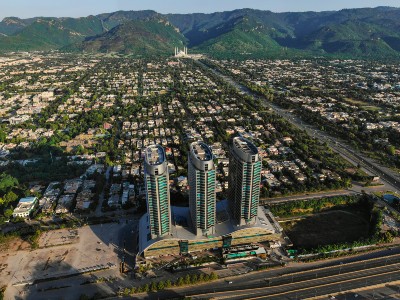
Azad Kashmir
Location: In northwestern Pakistan, just west of the Indian-controlled state of Jammu and Kashmir.
How to get there: Rent a car and drive from Islamabad. The journey takes around four and a half hours and takes you along the Islamabad-Murree-Muzaffarabad expressway and Rawalakot road.
The Pakistan region of Kashmir was once part of the state of Jammu and Kashmir. The Pakistan-administered region is known as Azad Kashmir, meaning ‘free Kashmir’, and is divided into three main divisions – Mirpur, Muzaffarabad and Poonch.
Thanks to the Neelum and Jhelum Rivers that snake through it, the region is covered in lush greenery, with the magnificent Himalayas as its backdrop. The only thing that could rival the beauty of its landscapes is Kashmir’s culture, shaped over centuries by communities that have travelled here from across the world. Many of the locals practise Sufism, a mystical form of the Islamic religion. Look out for the many Sufi shrines across the region, like the Pir Chinasi shrine that sits atop the Pir Chinasi mountain.
Some other incredible places to visit in Azad Kashmir include the Leepa Valley, with its terraced rice paddies, the ruins of the Red Fort in Muzaffarabad valley, and the tranquil Banjosa Lake.
Find out more about Azad Kashmir Explore Azad-Kashmir.
Ghizer Valley
Location: In the Gilgit-Baltistan region in northern Pakistan.
How to get there: Rent a car and drive to Ghizer from the city of Gilgit. It’s a two-hour journey to the main town of Gahkuch.
For most regions of Pakistan, tourism has been relatively untapped, but nowhere is this more true than Ghizer. In the past, the region’s infrastructure has been precarious, making it a difficult place to visit. Construction of new infrastructure and repairs of the old have gradually increased tourism in the area and now it's ready for your visit.
The area’s beauty and tranquillity are simply unparalleled. The pristine azure waters of the Gilgit River runs through Ghizer and alpine lakes and wetlands sit high in the mountains.
The town of Gahkuch is the commercial and administrative hub of Ghizer and is home to some great hotels and restaurants. From the town, you can also access Phander Valley, one of the most popular places in Ghizer with its trout-filled rivers and small villages, and the beautiful Khalti Lake, which freezes over in winter and becomes a playground for the locals. And no trip to Ghizer is complete without experiencing the locals’ favourite game: Polo!
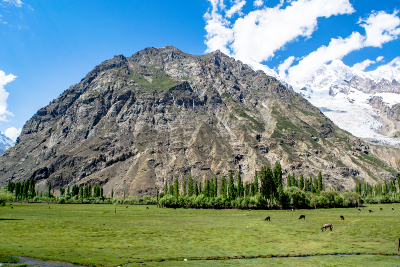
Naran Kaghan
Location: In the north of Pakistan, in the Khyber Pakhtunkhwa province.
How to get there: The best way to reach the Naran Kaghan region is by making your way to Mansehra, the closest city. Mansehra can be reached by renting a car and driving from the capital city of Islamabad via the newly constructed Hazara motorway, taking around two hours. From Mansehra, take Naran Road, a thin but metaled road, to Naran, which takes around three and a half hours.
Side by side, the Naran and Kaghan valleys offer up exceptional terrain for adventure-seekers. The region is the gateway to the north of Pakistan and is home to bustling trade markets full of curiosities and some wonderful tourist resorts too, making it one of the best tourist places in Pakistan.
With mountain peaks as high as 2,409m, the glacier-fed Kunhar River running the length of the valleys, and the dense forest in between, Naran Kaghan is thought by many to rival the Alps of Europe. This place has a charm all of its own, though, from the Siraiki and Gujjar tribes that work the land and hospitable residents ready to introduce you to the local delicacies.
For water lovers, a visit to Naran Kaghan is a must for the chance to raft on the mighty Kunhar River and to experience the enchanting Saif ul Malook Lake that sits high up among snow-capped peaks. Or, if you’re simply seeking some sanctuary, Naran Kaghan has lush alpine meadows, pristine lakes and more than its fair share of tranquil valleys.
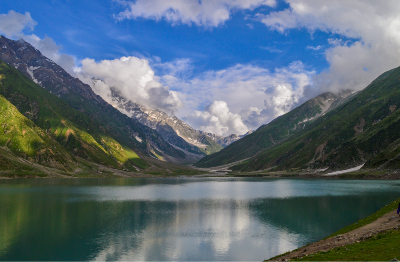
With PakVoyager’s online tour packages Pakistan travel is easier than ever before. So, wherever you choose to go, let us take care of you from start to finish, and explore the wonders of the country with one of our hand-picked Pakistan tour companies.
Click here to pick your perfect destination, then browse and buy Pakistan tour packages online.

